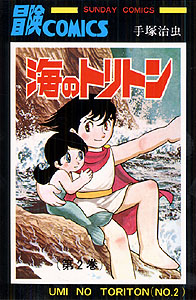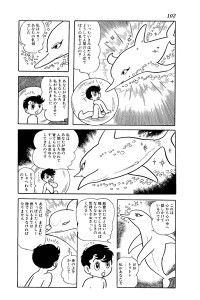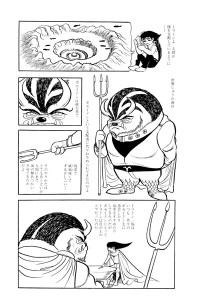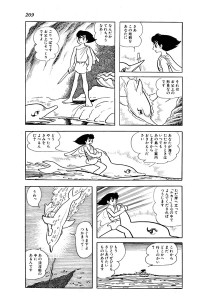Triton of the Sea (Manga)
Also known as 海のトリトン (Umi no Toriton)
| English Title: | Triton of the Sea |
| In English? | Yes |
| Japanese Title: | 海のトリトン [Umi no Toriton] |
| Type: | Ongoing Serial |
| Original run: | 1969/09/01 – 1971/12/31 |
| Published in: | Sankei Newspaper [[産経新聞] |
| Published by: | Sankei Shimbun Co., Ltd. |
| Volumes: | >4 (MT-189 | MT-190 MT-191 | MT-192 | MT-380) |
Triton of the Sea (1969-71) is Osamu Tezuka’s take on the legend of Atlantis and was published from September 1, 1969 to December 31, 1971, in the daily Sankei Newspaper. Originally serialized under the title Blue Triton, the title was later changed to Triton of the Sea to coincide with the 1972 full-colour animated television show.
What it’s about
One stormy night, a young boy name Kazuya, the son of a fisherman, sees a strange light emanating from a cliff near Cape Inokubi. He climbs down and discovers a baby lying on a bed of seaweed. When he brings the child back to the village, although his father is against the idea of having another mouth to feed, his mother takes to the baby right away. Surprisingly though, Kazuya’s grandmother insists that the baby be returned to where it was found lest it bring destruction to the village. As if on cue, the village is struck by a large earthquake and is nearly destroyed and Kazuya’s father is killed by the resulting tsunami while trying to save the fishing boats.
With no chance of income, Kazuya’s mother is forced to move the family, which now includes the mysterious baby, to Tokyo. Given the name “Triton”, the baby grows incredibly quickly and Kazuya is forced to forgo his education and take up menial jobs to help support the family. Eventually Kazuya falls in with a bad crowd and is forced to go on the run from the law. Meanwhile, Triton, still unsuspecting of his true origins, develops a strange aptitude for the water and begins training in extreme swimming with a grizzled old man. After an encounter with a golden dolphin named Ruka, Triton begins to understand that his past may be more complex than even he expected.
Eventually Triton learns that he is the last surviving member of the Triton clan, which was nearly exterminated by their ancient hereditary enemy, Poseidon. Thus begins Triton’s long struggle against Poseidon and his many monstrous offspring, in an attempt to find vengeance for his family and an understanding of his own identity.
What you should know
Triton of the Sea (1969-71) is, along with Captain Ozma (1961-64), Dove, Fly up to Heaven (1964-67) and Astro Boy Chronicles (1967-69), part of a series of works that Tezuka did for the Sankei Newspaper. After the daily serialization of the Astro Boy Chronicles (1967-69) manga in the Sankei Newspaper came to an end in February 1969, the editorial department approached Tezuka about a follow-up work. Tezuka’s response was Blue Triton (later renamed Triton of the Sea) and it ran from September 1 1969 to December 31 1971, with one page appearing each day. Although Tezuka borrowed the names “Triton” and “Poseidon” from ancient Greek mythology, that is where the similarities end – at its core, Triton of the Sea (1969-71) is primarily a marine-based science-fiction story. Originally, the young boy Kazuya Yazaki was intended to be the main protagonist of the story, however Tezuka quickly realized that readers were primarily drawn to the mysterious young Triton and Kazuya was left to drift out entirely of the middle part of the story, with Triton replacing him as the hero.
Also, it is interesting to note that, given the rising popularity of realistic sports manga at the time, Tezuka devoted a large part of the early story detailing Triton’s training in extreme swimming and underwater martial arts under the watchful eye of a cantankerous coach. As with many of his works, Triton of the Sea (1969-71) explores some of Tezuka’s favourite themes, and includes many elements of social/environmental commentary regarding the destruction of the natural world. The original manga story also spends much more time establishing Triton’s connection with his surface-dwelling human family than the subsequent animated television series. In this way, Tezuka is able to explore Triton’s search for identity – something commonly found in cases of abandoned children – in a much more meaningful way. This lends a lot of credence to Triton’s role in bridging the gap between the surface and underwater worlds.
Finally, it’s worth noting that, as a tie-in with the animated television program, Tezuka also did two short children’s tales featuring a storyline adapted from Triton of the Sea (1969-71). Only a handful of pages each, they were published in TV Magazine and Pleasant Kindergarten in May 1972.
Where you can get it
Luckily for English-speaking fans, in 2013 Triton of the Sea was published by DMP as part of their “Osamu Tezuka Family Pack” campaign. A total of 715 backers pledged $49,411 (of an initial $20,500 goal) to successful fund the publication of Uncio, Atom Cat and Triton of the Sea. Triton of the Sea was the second stretch goal, successfully unlocked when the campaign reached $47,000.






